| |
|
How would the painter or poet express anything other than his
encounter with the world?
Maurice Merleau-Ponty,
Signs
The production of architecture can be situated between two
(sometimes dialectically opposed) positions. On the one view architecture is borne of social or economic need,
reflective of the values of a cultural or political situation. On the other view architecture is
generated as an ideal of pure conceptualization or with an internal hermetic
logic that is already complete but can be programmed or not.
K. Michael Hays in “Critical Architecture: Between Culture
and Form,” describes critical architecture as cutting across the dichotomy of
social / cultural context and form to occupy a position that is resistant and oppositional
“This is
an architecture that cannot be reduced either to a conciliatory
representation of external forces or to a dogmatic, reproducible formal
system. If a critical architecture is
to be worldly and self-aware simultaneously, its
definitions is in its difference from other cultural manifestations
and from a priori categories or methods.”
In addition, Kenneth Frampton contends that the evolution
of 20th century architecture has been determined by a different
set of antithetical impulses. On the
one hand architecture is generated by avant-gardist
cultural politics and avant-gardist art, and on the
other hand is the countervailing determination to the development of
architecture as a “socio-tectonic art form that necessarily places a primary
emphasis on the poetics of construction on the role that architecture
unavoidably plays in the formation of the social world.” One view might be called revolutionary and
the other might be called evolutionary.
Our work seeks to engage the production of critical
architecture while simultaneously employing revolutionary drives and
evolutionary movement. At a
fundamental level, the necessity of architecture in our work is about
experience of architecture to move one intellectually, spatially and
spiritually.
|
 |
|
The making and the experience of Architecture is the
auto-construction of consciousness and Being. By auto-construction, we mean the ability of the process to self
generate one’s consciousness of the things around us. More precisely, it is the raising on one’s
subconscious to the relationship with the cosmos, to one’s own will, and to
life itself. Heidegger called this
state of existence “Being”
and Nietzsche called this state of existence the “Ubermench.” Put another way, the process of
manifestation and actualizing one’s own possibilities and potential-for-Being
is the conscious act of creating architecture; for Architecture is always the
very first act of creation. (One must construct shelter or a home for oneself
given a set of circumstance and conditions that exist in the world.)
Point 1: Hence, the task of Architecture is
the ordering of space-time and the construction of existential meaning and
knowledge through encounters with the world.
Yet Architecture must not be equated with the mere act of
building or simply dwelling. The
necessity for architecture must be coupled with the desire for
knowledge which seeks fixity, endurance, constancy, stasis, and identity
which are all lacking in the actual world and thus provide no stable ground
for Architecture. Hence, the Architect
as does the poet must construct Architecture through the exploitation of
uncertainties and structural tropes as a means for expressing consciousness
on a ground, which is slippery and illusory.
Point 2: The task of Architecture is to exist
critically in the world simultaneously self-conscious and engaged in cultural
discourse through interpretation and translation of cultural and geographical
situations.
|
 |
|
Yet the program of Architecture is not merely functional
need, but it is also aesthetic / spiritual need. By aesthetic need we may turn again to
Nietzsche who remarked on rapture as the basic aesthetic state. Nietzsche wrote in Twilight’s of the
Idols (1888) “What is essential in rapture is the feeling of enhancement
of force and plenitude.” He speaks of
rapture as a feeling; he describes “a mode of the
embodying, attuned stance towards beings as a whole.” These feelings are reflected in what is
regarded as beautiful.
Hence, the beautiful reflects what the ascent beyond
ourselves hold in store, an ascent which occurs in the state of rapture and
is accompanied by feelings of enhancement of force and of plenitude. The level to which ones forces have
ascended is the determining factor in deciding what is to be esteemed
beautiful. The beautiful is what is
disclosed in rapture and what transports us into this feeling.
Similarly, Leibniz (the German philosopher and mathematician)
defines this condition as the revelation of an “event” which though it may
not have an empirical or historical basis happens to be the virtual sensation
of a somatic moment of totalization and
dispersion. In the novel or in poetry,
it can be felt as a seriality of epiphany – that
sudden, intuitive perception of or insight into the reality or essential
meaning of something, usually initiated by some simple, homely, or
commonplace occurrence or experience.
This event may lead to rapture or that feeling of force and
plenitude. “Its scientific analogies
might include the thoughts of infinity that come with the view of the world
which all of its visible objects are moving aggregates of infinite of numbers
of atoms and molecules.” (Leibniz) |

|
|
Point 3: The task of architecture is not about
style, fashion, and formalism.
In the academy and within the profession, architecture is
often defined as a unique fusion of form and place. Such a simplistic definition has
constructed numerous traps operating in the web of formalism, fashion, and
"style” giving way to the dangers of aestheticism.
|
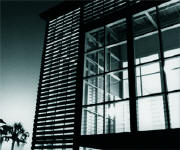 |
|
In order to overcome the dangers of aestheticism; the
traps of formalism; and the pitfalls of re-engendered differénce
architects must return to the examination of the nature of architecture to
radicalize and capture the rarefied areas of sensation that establish
presence and meaning in what Plato calls the chora of our everyday existence. Chora is defined by Plato in Timaeus as the
space between Being and becoming. Chora is a space "which is eternal and
indestructible, which provides a position for everything that comes to be,
and which is apprehended without the senses by a sort of spurious reasoning
and is so hard to believe in we look at it indeed in a kind of dream and say that everything that exists must be
somewhere and occupy some space, and that what is nowhere in heaven or earth
is nothing at all."
It is in the space of human creation and participation
that is abstract yet ambiguous and poetic --- mysterious and full of meaning.
|
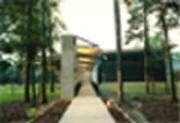 |
|
In our work, it is the ordering of space-time wrapped in
poetry, imagination, and mystery relative to a particular cultural context
that motivates the work. Furthermore,
the idea of a cultural context is inextricably bound to landscape: For culture is defined by ones relationship
to a particular place in terms of geography, geology, and the relative
position of that place in time to all other places in time.
The issue of culture and its relationship to our understanding
of space-time is significant in our work as African American architects born
of the South and practicing architecture in the South. However, the work is
not about regionalism.
For in the South exist sets of
actual and virtual realities situated between what is said and what is
unspoken, between idiosyncrasies and suspicion; between the past and a
represented present; and between “knowing your place” and negotiating
stereotypes and expectations.
|
 |
|
Simultaneously, the South seeks to
deny and to confirm its appearance and its stereotype thereby distorting
one’s perspective.
(Hence, we were recently asked by the
National Building Museum to design a “House for a Future President” in
conjunction with an exhibit on Mount Vernon that is currently on view in
Washington, we situated our design in an inner city neighborhood in
Charleston. The site for the project
stands at an important intersection, and incorporates elements of an
installation by the artist David Hammons created for the 1991 Spoleto
Festival. The traditions of the
African American community’s use of public space and the nature of social
intercourse within this community are profoundly important and play a major
role in the programming of the house and the site. The project calls for a new “living room”,
a transparent building that serves as the primary public space. The transparent structure is appended to an
existing Charleston “single house,” which holds the
family’s private quarters. Associated
program elements such as Secret Service facilities, press facilities, guest
quarters, etc., are located in other renovated houses dispersed among the
regular private houses in the neighborhood. Although security remains paramount in the consideration of the
president’s house, in this case the neighborhood itself provides that
security. It derives from the
relationship between neighborhood and native son, at once self-regulating and
reaffirming.)
|
 |
|
For what is on view for the casual visitor or tourist is
only a constructed face … an appearance (or -appearance
if you will) of circumstances hidden from view.
|
| |
|
Additionally, What motivates our work is the
interpretation and translation of this cultural context (or any cultural
context) and how we come to terms with this place to reveal meanings,
situations, and conditions (both apparent and subliminal).
The work is about questions of theoretical grounds and
fields of conditions;
about questions of the “in-between” and the edge of
revelation;
questions of presence but also the presence of absence;
about questions of relativity and the curvature of
space-time;
about questions of the temporal but never the temporary;
|
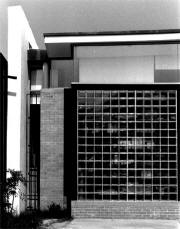 |
|
about
tectonic strategies of building and the tectonics of culture;
timelessness but not timeliness;
|
| |
|
the multivalency of layering but
not the sexiness of skin;
about meanings lurking under the skin-deep tones of
race, class, and ethnicity.
The work is therefore not about the superficiality of skin
and surface. But at the exterior edges
of architecture are layered conditions that are phenomenally transparent;
clearly ambiguous; and a perceptual enmeshing of systems and structures of
concepts and building.
At the edge of architecture is the ability to
subconsciously slip into its viscous thickness as the threshold and
transformation into that indefinable “zone” to reveal architecture in a
frontier unknown and previously unconfronted in our
conscious existence yet paradoxically constituted by the “known”.
Slippage into and through the “zone” yields a suspension
of time, and a deformation and warpage of space
where one is both passenger and observer.
|
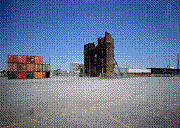 |
|
The issues surrounding this question of Baukultur I suspect are not
entirely unique to
Germany.
Although it appears there are subtleties to the concept that I am only just
beginning to fathom. In
America,
we too struggle with these very same questions: how do we understand
‘Culture’ and the role of culture in a distantiated
condition? Can we modernize aestheticism? Should we? What is the nature of
the social perspective? These very questions are under considerable debate
within my own city,
Charleston,
an old city with an exceptional historical architectural stock albeit filled
with contradictions, that is now bristling under the
dialectic of old versus new, historicism versus modernism, pastiche versus
quality.
For certain the answers are not easy ones. Tonight, I
would like to tell you of an experiment - an experiment that attempts to
engage these questions in, for
America,
an almost unprecedented way. Then, if you’ll allow me, I would like to offer
a few thoughts about the work of my studio, Huff + Gooden Architects and to
present two recent works. I struggled in preparing this lecture, which for me
is a bit of a disjoint, on the one hand reporting on a national agenda, and
on the other, to talk about a more personal pursuit. But, if you’ll bear with
me, I try my level best.
|
| |
|
DESIGN EXCELLENCE |
 |
|
In 1962, Daniel Patrick Moynihan, then a
Assistant Secretary to the Navy, was involved in the development of a
bureaucratic report on the nation’s public real estate holdings entitled,
fittingly: Report to the President by the Ad Hoc Committee on Federal
Office Space.
|
| |
|
Moynihan decided there had to be more to government
architecture than functional needs, so overnight he penned what is called the
Guiding Principles for Federal
Architecture. This seemingly innocuous amendment to the report proved to
be a profoundly simple didactic that has shaped Federal architecture ever
since. Simply put, the principles aptly described the intent:
-
Produce facilities that reflect
the dignity, enterprise, vigor, and stability of the Federal Government.
-
Incorporate the work of living
artists in public buildings.
-
Development of an official style
must be avoided.
-
Pay
special attention to the general ensemble of streets and public places.
A few other Moynihan quotes from the Guiding Principles
that have resonated for me personally, a) “Major emphasis should be placed on the choice of designs that embody
the finest contemporary American
architectural thought”;
b) “Design must flow from the architectural
profession to the Government, and not vice versa;
c) The Government must be willing to pay some additional cost to avoid
excessive uniformity in design of Federal buildings.”
|
 |
|
The
Design Excellence Program, started in 1994, is the initiative that flowed
from the report by, of all groups, the General Services Administration (GSA)
- essentially the real estate arm of the government. The principle stated
goal of the program is none less than to change the course of public
architecture in the Federal Government.
It
is these principles that are at the foundation of the Design Excellence
Program. The program mandates that significant Federal buildings must achieve
the highest ideals of quality. The fundamentals of the program can be
described as follows:
-
Encouraging leading designers
and emerging designers to pursue government commissions by streamlining
the selection process and placing great emphasis on the Lead Designer;
-
Use of design competition charrettes;
-
Development of the PEER design
professionals program;
-
Involving the target client in
the design process;
-
Establishment of a design awards
program;
-
Serve as a model for all Federal
building programs;
-
Creating
a public relations ‘climate’ where good design is expected.
The two most important elements of this program are the
selection process and the PEER professionals program. Selecting designers
based on their portfolio and design philosophy rather than quantitative
information makes it possible to commission the most talented designers. The
PEER program is the involvement of design professionals who assist in the
selection of architects, serve as design critics, participate in design charrettes, etc. I believe these two approaches
constitute a large part of the success of the Design Excellence program.
|
 |
|
Let’s look at the program. If one examines the legacy of
Federal architecture, an interesting story is revealed. In the past,
government buildings aspired to the highest ideals at the time. Such as the
Federal
Court & Supreme Court
Building
in
Foley Square,
New York,
designed by Cass Gilbert in 1934.
|
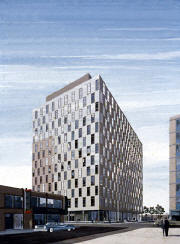 |
|
In the near past however, Federal architecture lost its
way and suffered the generic banalities of badly done International Style
buildings.
With the advent of GSA’s Design Excellence and emphasis on
good design, a new era of Federal architecture emerged. GSA determined that
major civic buildings had to again aspire to the greatest ideals of the time.
|
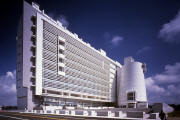 |
|
Congress funded a major initiative with the Courts
Expansion Program that resulted in a number of significant designs all of
which are direct beneficiaries of the initiative. Today, we are seeing the
results of this effort.
Aside
about cab driver
|
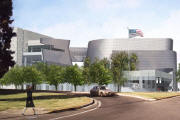 |
|
Current projects under development by GSA continue this
tradition of excellence in design.
|
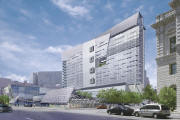 |
|
The success of the initiative has prompted leading
designers in
America
to aggressively pursue GSA work – such as Tom Mayne
of Morphosis and many others. The program has also
‘raised the bar’ and has set a standard for good design in the
US.
Architects see GSA projects as prized commissions.
Moynihan’s vision and forethought was a catalyst for a
renewed design consciousness that at its roots is a reconsideration of
architecture as a means to explore culture and knowledge.
It was he who said: “America
deserves architecture as good as its people are”. I would say,
Germany
deserves architecture as good as its people; the World deserves architecture
as good as its people.
|
|
|
feedback |
|

Vol. 8, No. 2
(March 2004) |


